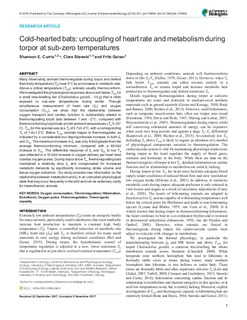| dc.contributor.author | Currie, Shannon E | |
| dc.contributor.author | Stawski, Clare | |
| dc.contributor.author | Geiser, Fritz | |
| dc.date.accessioned | 2019-04-01T09:08:01Z | |
| dc.date.available | 2019-04-01T09:08:01Z | |
| dc.date.created | 2017-11-23T15:12:39Z | |
| dc.date.issued | 2018 | |
| dc.identifier.citation | Journal of Experimental Biology. 2018, 221 1-8. | nb_NO |
| dc.identifier.issn | 0022-0949 | |
| dc.identifier.uri | http://hdl.handle.net/11250/2592642 | |
| dc.description.abstract | Many hibernating animals thermoregulate during torpor and defend their body temperature (Tb) near 0°C by an increase in metabolic rate. Above a critical temperature (Tcrit), animals usually thermoconform. We investigated the physiological responses above and below Tcrit for a small tree-dwelling bat (Chalinolobus gouldii, ∼14 g) that is often exposed to sub-zero temperatures during winter. Through simultaneous measurement of heart rate (fH) and oxygen consumption (V̇O2), we show that the relationship between oxygen transport and cardiac function is substantially altered in thermoregulating torpid bats between 1 and −2°C, compared with thermoconforming torpid bats at mild ambient temperatures (Ta 5–20°C). Tcrit for this species was at a Ta of 0.7±0.4°C, with a corresponding Tb of 1.8±1.2°C. Below Tcrit, animals began to thermoregulate, as indicated by a considerable but disproportionate increase in both fH and V̇O2. The maximum increase in fH was only 4-fold greater than the average thermoconforming minimum, compared with a 46-fold increase in V̇O2. The differential response of fH and V̇O2 to low Ta was reflected in a 15-fold increase in oxygen delivery per heart beat (cardiac oxygen pulse). During torpor at low Ta, thermoregulating bats maintained a relatively slow fH and compensated for increased metabolic demands by significantly increasing stroke volume and tissue oxygen extraction. Our study provides new information on the relationship between metabolism and fH in an unstudied physiological state that may occur frequently in the wild and can be extremely costly for heterothermic animals. | nb_NO |
| dc.language.iso | eng | nb_NO |
| dc.publisher | Company of Biologists | nb_NO |
| dc.relation.uri | http://jeb.biologists.org/content/221/1/jeb170894.abstract | |
| dc.title | Cold-hearted bats: uncoupling of heart rate and metabolism during torpor at sub-zero temperatures | nb_NO |
| dc.type | Journal article | nb_NO |
| dc.type | Peer reviewed | nb_NO |
| dc.description.version | publishedVersion | nb_NO |
| dc.source.pagenumber | 1-8 | nb_NO |
| dc.source.volume | 221 | nb_NO |
| dc.source.journal | Journal of Experimental Biology | nb_NO |
| dc.identifier.doi | 10.1242/jeb.170894 | |
| dc.identifier.cristin | 1517810 | |
| dc.description.localcode | © 2018. Published by The Company of Biologists Ltd. Available online at: https://doi.org/10.1242/jeb.170894 | nb_NO |
| cristin.unitcode | 194,66,10,0 | |
| cristin.unitname | Institutt for biologi | |
| cristin.ispublished | true | |
| cristin.fulltext | original | |
| cristin.qualitycode | 2 | |
